AMD Announces New $55 Low-Power Processor: Athlon 200GE
by Ian Cutress on September 6, 2018 9:00 AM EST
Everyone likes discussing headlines: the latest mainstream processor, or super 32-core behemoth, are topics ripe for deep discussion. Despite this, a lot more volume occurs in the mid-range and low-end of the product stack. Never mind $299 for a CPU, there is a lot of action that occurs under $100. With that in mind, AMD is announcing its new $55 processor with integrated graphics, designed to sit under the Ryzen 5 2200G that we tested earlier this year. The Athlon 200GE by comparison has two cores with simultaneous multi-threading, three compute units for graphics, and a 35W TDP, all for $55.
Expanding The Low Cost Product Line
With this new product, AMD is changing what Athlon stands for – in previous generations, Athlon was for a processor that has its integrated graphics disabled. Now AMD is using it in the same way that Intel uses the Pentium or Celeron brands: for low cost, high volume products. This new part is designed to be a more cost-effective solution for users that need both a processor and graphics in a single system. Add in 4GB of memory and some storage, and the aim is a very competent system for very little money.
The introduction of the Athlon 200GE puts AMD’s current lineup as follows:
| AMD's Mainstream Stack | |||||||
| AnandTech | Zen | Cores w/HT |
Base Freq |
Turbo Freq |
Vega CUs |
TDP | MSRP |
| Ryzen 7 2700X | Zen+ | 8 / 16 | 3700 | 4300 | - | 105W | $329 |
| Ryzen 7 2700 | Zen+ | 8 / 16 | 3200 | 4100 | - | 65W | $299 |
| Ryzen 5 2600X | Zen+ | 6 / 12 | 3600 | 4200 | - | 95W | $229 |
| Ryzen 5 2600 | Zen+ | 6 / 12 | 3400 | 3900 | - | 65W | $199 |
| Ryzen 5 1500X | Zen | 4 / 8 | 3500 | 3700 | - | 65W | $159 |
| Ryzen 5 2400G | Zen | 4 / 8 | 3600 | 3900 | 11 | 65W | $169 |
| Ryzen 5 2400GE* | Zen | 4 / 8 | 3200 | 3800 | 11 | 35W | * |
| Ryzen 3 1300X | Zen | 4 / 4 | 3500 | 3700 | - | 65W | $114 |
| Ryzen 3 2200G | Zen | 4 / 4 | 3500 | 3700 | 8 | 65W | $99 |
| Ryzen 3 2200GE* | Zen | 4 / 4 | 3200 | 3600 | 8 | 35W | * |
| Athlon 240GE | Details to be disclosed in Q4 | ||||||
| Athlon 220GE | Details to be disclosed in Q4 | ||||||
| Athlon 200GE | Zen | 2 / 4 | 3200 | - | 3 | 35W | $55 |
| * Released but not at retail | |||||||
The Athlon 200GE is a dual core processor with simultaneous multi-threading, and no turbo: it will run at 3.2 GHz at all times. The TDP is the biggest adjustment, with AMD offering a low-cost low-power 35W product. The three compute units will be plenty for all office tasks and some light gaming. However that $55 price point means that AMD believes it will be competing with products like the Pentium G4560 (despite it being a generation old) and replacing the popular Bristol Ridge-based A6-9500E. As this is an APU, the cores are still ‘first generation Zen’, however AMD is aiming to align the part with its second generation family.
Update: AMD has updated its materials to include that it will be releasing an Athlon 220GE and Athlon 240GE later this year. The table has been updated.
AMD states that the new part will offer 4K display output (due to the integrated Vega graphics), native USB 3.1 support, as well as NVMe SSD support. The processor is AM4 socket compatible, which means that it can be enabled for at least DRAM overclocking (AMD confirmed that the CPU is locked for frequency overclocking though, like the Pro CPUs).
At $55, it fits in at just under half the price of the quad-core Ryzen 5 2200G with under half the graphics and just over half the TDP. For anyone looking at a low cost system, AMD now has a good Zen-based competitor, where before there was none.
There Are Also Some New Pro CPUs
In line with the consumer launch, AMD is also expanding its Pro processor line. The Pro processors are the professional/enterprise versions of the consumer parts, designed for business deployments and offer additional management features as well as reliability / availability and a commercial warranty. Businesses looking to deploy Ryzen will look at these parts over the standard consumer parts in order to have control and knowledge of guaranteed support.
The new parts are from AMD’s second generation of Ryzen, and thus are built on the 12nm process with additional tweaks for faster cache accesses. In our review of the second generation Ryzen parts, we showed that AMD’s claim of +3% clock-for-clock performance held true, and ballooned to +10% when the higher frequencies came into effect. The lead time to make these processors ready for commercial is longer, hence the difference in timings between the consumer and professional launches.
| AMD's Pro Stack | ||||||
| AnandTech | Zen | Cores w/HT |
Base Freq |
Turbo Freq |
Vega CUs |
TDP |
| Ryzen 7 Pro 2700X | Zen+ | 8 / 16 | 3700 | 4300 | - | 105W |
| Ryzen 7 Pro 2700 | Zen+ | 8 / 16 | 3200 | 4100 | - | 65W |
| Ryzen 5 Pro 2600 | Zen+ | 6 / 12 | 3400 | 3900 | - | 65W |
| Ryzen 5 Pro 1500 | Zen | 4 / 8 | 3500 | 3900 | - | 65W |
| Ryzen 5 Pro 2400G | Zen | 4 / 8 | 3600 | 3900 | 11 | 65W |
| Ryzen 5 Pro 2400GE | Zen | 4 / 8 | 3200 | 3800 | 11 | 35W |
| Ryzen 3 Pro 1300 | Zen | 4 / 4 | 3500 | 3700 | - | 65W |
| Ryzen 3 Pro 2200G | Zen | 4 / 4 | 3500 | 3700 | 8 | 65W |
| Ryzen 3 Pro 2200GE | Zen | 4 / 4 | 3200 | 3600 | 8 | 35W |
| Athlon Pro 200GE | Zen | 2 / 4 | 3200 | - | 3 | 35W |
The four new processors are the Ryzen 7 Pro 2700X, 2700, 2600X, and the Athlon Pro 200GE, the latter matching the consumer product also announced today. AMD’s Pro product stack is now filling out with APUs and the latest generation parts, which will be good news to OEMs that deploy systems based on these. The low-cost 200GE should also help with thin clients that require video output.
Availability
The Athlon 200GE should be on shelves within weeks, while the Pro lines will be integrated into OEM systems when those OEMs have analyzed their product strategies, perhaps in Q4.
Can We Talk About the New Athlon Logo
The first thing that struck me with this announcement was that the Athlon logo had been adjusted. Several exhibits as shown in reverse chronological order:
Having the name Athlon in the ‘Ryzen’ font just doesn’t look quite right. The chip isn’t called a Ryzen, like the regular CPUs, Threadripper, or like EPYC. Maybe it’s just me. It makes me wonder how good/bad the Opteron name would be in this font. Thoughts?
Related Reading
- Marrying Vega and Zen: The AMD Ryzen 5 2400G and Ryzen 3 2200G Review
- Zen and Vega DDR4 Memory Scaling on AMD's APUs
- AMD Ryzen 5 2400G and Ryzen 3 2200G Core Frequency Scaling: An Analysis
- Overclocking The AMD Ryzen APUs: Guide and Results
- Delidding The AMD Ryzen 5 2400G APU: How To Guide and Results
- AMD Launches Ryzen 3 2200GE & Ryzen 5 2400GE 35 W APUs
- AMD Launches Ryzen Pro with Vega: Mobile APUs and Desktop APUs


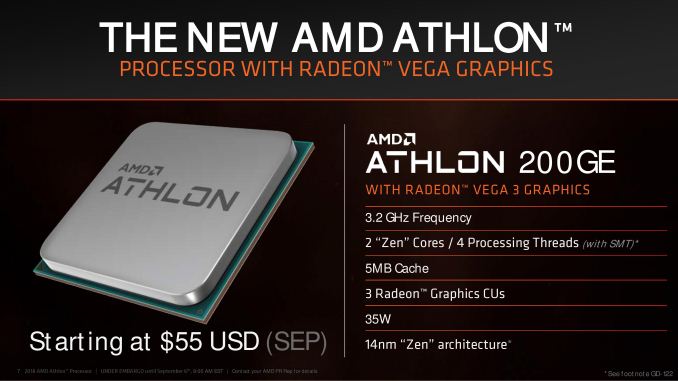
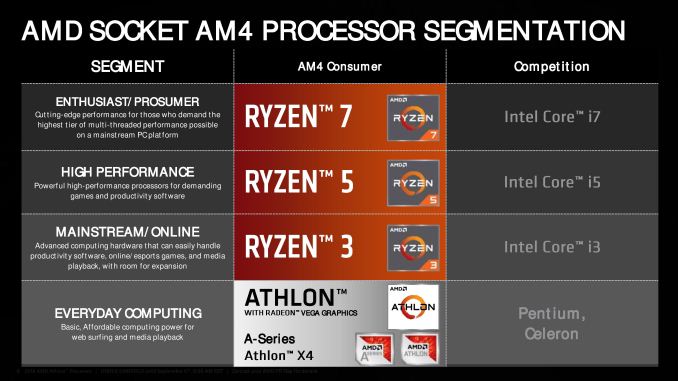
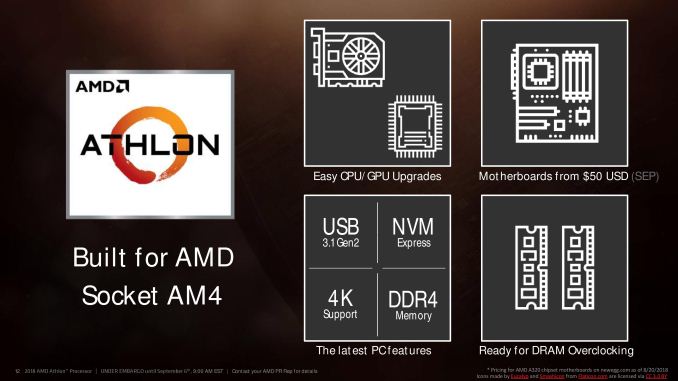
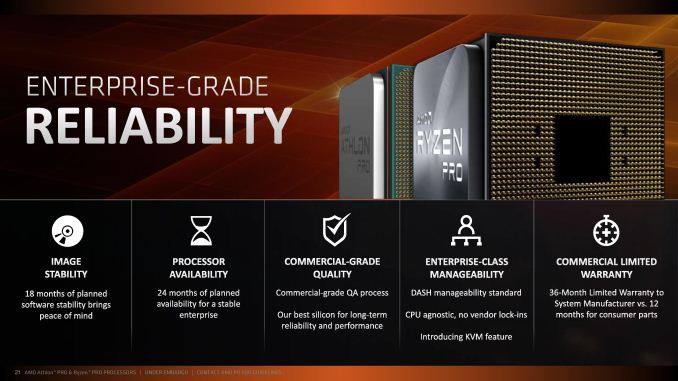


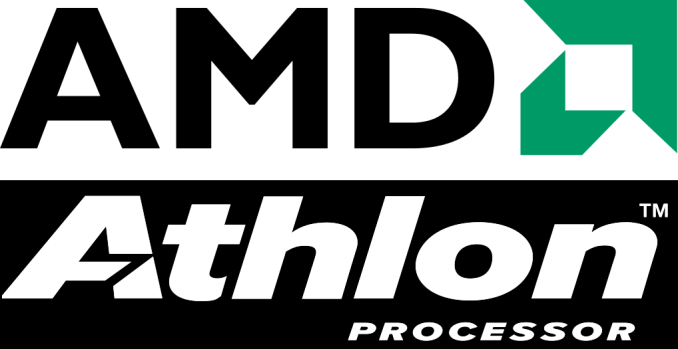








44 Comments
View All Comments
John_M - Sunday, September 9, 2018 - link
Which AM4 motherboards are known to have the traces though and, more importantly, have the BIOS support for ECC RAM?Ad-Man-Gamer - Monday, December 3, 2018 - link
From what I understand, ECC was broken on the raven ridge APU's. People thought that it would be fixed with the pro line, but it was not. So why would it be fixed on this Athlon?MonkeyPaw - Thursday, September 6, 2018 - link
Makes me wonder what the other 2 Athlon tiers will be. Better clocks? More CUs?psychobriggsy - Thursday, September 6, 2018 - link
Certainly better (but fixed) clocks for the CPU.Prediction, assuming all are 35W:
220GE - 3.5GHz 3CU $69 (perhaps graphics clocked a bit higher too)
240GE - 3.5GHz 5CU $82
I presume the price includes a cheap-ass cooler of some kind as well.
sing_electric - Friday, September 7, 2018 - link
I was thinking the same thing. Everything's got to be less than the entry-level Ryzen G, so I'm thinking they stay at 2 cores/4 threads with a locked clock, and maybe add a CU or two as you go up, and possibly slightly better clock.Still, that's it's nuts to think they'll have a total of 4 APUs between $55-$99 SEP - that's a lot of chips separated by like, the cost of a burrito.
Midwayman - Wednesday, September 12, 2018 - link
I feel like that should be the new metric for cost difference in computer parts. Well, I really want a 2080, but that's like 33 burritos more than I expected!PeachNCream - Thursday, September 6, 2018 - link
Typo: "Everyone lines discussing headlines:"Maybe "Everyone likes discussing headlines:"
Dragonstongue - Thursday, September 6, 2018 - link
hmm 2 core 4 thread, IMO they should have targeted 3.4Ghz at minimum (so basically a modernized Phenom II 965) I am with others that state should be "unlocked" likely that "ability" costs ZERO to enable seeing as it is built on Zen coreDeath666Angel - Friday, September 7, 2018 - link
It's not about the cost of enabling overclocking (should just be a microcode thing, no?). It is about possibly cannibalizing the sales of more expansive CPUs/APUs. That's been the whole reason why Intels CPU structure is like it is. It does not cost them more to enable certain features in production. It costs them more in lost sales of higher end items.I'm fine with this SKU as it is. If I wanted a performance-ish orientated processor, I'd spring for a 4c one with better graphics. The higher price would not matter much when building a whole system for me and the resale/reuse value is much greater. If I were to build something with this processor, I'd likely leave it as is anyway, since the extra performance would not matter much in the use case (NAS/server/router type thing) and the lower power draw would be meaningful when running 24/7.
Jimster480 - Friday, September 7, 2018 - link
Thats exactly what I was thinking.I'm just glad they have an SKU to compete now.